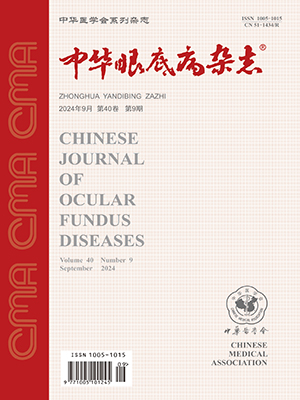| 1. |
陈有信, 张碧磊, 张弘哲. 眼科人工智能技术的现状与问题[J]. 中华眼底病杂志, 2019, 35(2): 119-123. DOI: 10.3760/cma.j.issn.1005-1015.2019.02.003.Chen YX, Zhang BL, Zhang HZ. Insights and prospectives of ophthalmologic artificial intelligence technology[J]. Chin J Ocul Fundus Dis, 2019, 35(2): 119-123. DOI: 10.3760/cma.j.issn.1005-1015.2019.02.003.
|
| 2. |
李建军, 徐亮, 路从磊, 等. 远程眼科阅片及时性及阅片报告详细性的初步研究[J]. 眼科, 2016, 25(1): 13-17. DOI: 10.13281/j.cnki.issn.1004-4469.2016.01.004.Li JJ, Xu L, Lu CL, et al. The timeliness of the image reading and the description details of the reading reports in teleophthalmology[J]. Ophthalmology in China, 2016, 25(1): 13-17. DOI: 10.13281/j.cnki.issn.1004-4469.2016.01.004.
|
| 3. |
Kapoor R, Whigham BT, Al-Aswad LA. Artificial intelligence and optical coherence tomography imaging[J]. Asia Pac J Ophthalmol (Phila), 2019, 8(2): 187-194. DOI: 10.22608/APO.201904.
|
| 4. |
Rahimy E. Deep learning applications in ophthalmology[J]. Curr Opin Ophthalmol, 2018, 29(3): 254-260. DOI: 10.1097/ICU.0000000000000470.
|
| 5. |
Litjens G, Kooi T, Bejnordi BE, et al. A survey on deep learning in medical image analysis[J]. Med Image Anal, 2017, 42: 60-88. DOI: 10.1016/j.media.2017.07.005.
|
| 6. |
Shen D, Wu G, Suk HI. Deep learning in medical image analysis[J]. Annu Rev Biomed Eng, 2017, 19: 221-248. DOI: 10.1146/annurev-bioeng-071516-044442.
|
| 7. |
Du XL, Li WB, Hu BJ. Application of artificial intelligence in ophthalmology[J]. Int J Ophthalmol, 2018, 11(9): 1555-1561. DOI: 10.18240/ijo.2018.09.21.
|
| 8. |
Ting DSW, Peng L, Varadarajan AV, et al. Deep learning in ophthalmology: the technical and clinical considerations[J/OL]. Prog Retin Eye Res, 2019, 72: 100759[2019-04-29]. https://pubmed.ncbi.nlm.nih.gov/31048019/. DOI: 10.1016/j.preteyeres.2019.04.003.
|
| 9. |
Li Z, Li W, Wei Y, et al. Deep learning based automatic diagnosis of first-episode psychosis, bipolar disorder and healthy controls[J/OL]. Comput Med Imaging Graph, 2021, 89: 101882[2021-02-25]. https://pubmed.ncbi.nlm.nih.gov/33684730/. DOI: 10.1016/j.compmedimag.2021.101882.
|
| 10. |
Hu J, Shen L, Albanie S, et al. Squeeze-and-excitation networks[J]. IEEE Trans Pattern Anal Mach Intell, 2020, 42(8): 2011-2023. DOI: 10.1109/tpami.2019.2913372.
|
| 11. |
Huang G, Liu Z, Laurens van der M, et al. Densely connected convolutional networks[C]//IEEE 2017 IEEE Conference on Computer Vision and Pattern Recognition (CVPR). Honolulu, 2017: 2261-2269. DOI:10.1109/cvpr.2017.243.
|
| 12. |
Wang F, Jiang MQ, Qian C, et al. Residual attention network for image classification[C]//IEEE 2017 IEEE Conference on ComputerVision and Pattern Recognition (CVPR). Honolulu, 2017: 6450-6458. DOI:10.1109/CVPR.2017.683.
|
| 13. |
Wang X, Tang F, Chen H, et al. UD-MIL: uncertainty-driven deep multiple instance learning for OCT image classification[J]. IEEE J Biomed Health Inform, 2020, 24(12): 3431-3442. DOI: 10.1109/JBHI.2020.2983730.
|
| 14. |
Lee CS, Baughman DM, Lee AY. Deep learning is effective for the classification of OCT images of normal versus age-related macular degeneration[J]. Ophthalmol Retina, 2017, 1(4): 322-327. DOI: 10.1016/j.oret.2016.12.009.
|
| 15. |
Kermany DS, Goldbaum M, Cai W, et al. Identifying medical diagnoses and treatable diseases by image-based deep learning[J]. Cell, 2018, 172(5): 1122-1131. DOI: 10.1016/j.cell.2018.02.010.
|
| 16. |
Mehta N, Lee CS, Mendonça LSM, et al. Model-to-data approach for deep learning in optical coherence tomography intraretinal fluid segmentation[J]. JAMA Ophthalmol, 2020, 138(10): 1017-1024. DOI: 10.1001/jamaophthalmol.2020.2769.
|
| 17. |
Lu W, Tong Y, Yu Y, et al. Deep learning-based automated classification of multi-categorical abnormalities from optical coherence tomography images[J]. Transl Vis Sci Technol, 2018, 7(6): 41. DOI: 10.1167/tvst.7.6.41.
|
| 18. |
Hwang DK, Hsu CC, Chang KJ, et al. Artificial intelligence-based decision-making for age-related macular degeneration[J]. Theranostics, 2019, 9(1): 232-245. DOI: 10.7150/thno.28447.
|
| 19. |
Milea D, Najjar RP, Zhubo J, et al. Artificial intelligence to detect papilledema from ocular fundus photographs[J]. N Engl J Med, 2020, 382(18): 1687-1695. DOI: 10.1056/NEJMoa1917130.
|
| 20. |
Goldberg RA, Waheed NK, Duker JS. Optical coherence tomography in the preoperative and postoperative management of macular hole and epiretinal membrane[J/OL]. Br J Ophthalmol, 2014, 98 Suppl 2: Sii20-ii23[2014-03-13]. https://pubmed.ncbi.nlm.nih.gov/24627250/. DOI: 10.1136/bjophthalmol-2013-304447.
|
| 21. |
Hee MR, Puliafito CA, Wong C, et al. Optical coherence tomography of macular holes[J]. Ophthalmology, 1995, 102(5): 748-756. DOI: 10.1016/s0161-6420(95)30959-1.
|
| 22. |
Hee MR, Puliafito CA, Wong C, et al. Quantitative assessment of macular edema with optical coherence tomography[J]. Arch Ophthalmol, 1995, 113(8): 1019-1029. DOI: 10.1001/archopht.1995.01100080071031.
|
| 23. |
Ferrara D, Waheed NK, Duker JS. Investigating the choriocapillaris and choroidal vasculature with new optical coherence tomography technologies[J]. Prog Retin Eye Res, 2016, 52: 130-155. DOI: 10.1016/j.preteyeres.2015.10.002.
|
| 24. |
Zhukova SI. Znachenie opticheskoi kogerentnoi tomografii s funktsiei angiografii v diagnostike miopicheskoi khorioidal'noi neovaskulyarizatsii [Optical coherence tomography angiography in the diagnosis of myopic choroidal neovascularization][J]. Vestn Oftalmol, 2021, 137(5): 68-77. DOI: 10.17116/oftalma202113705168.
|
| 25. |
Kanagasingam Y, Bhuiyan A, Abràmoff MD, et al. Progress on retinal image analysis for age related macular degeneration[J]. Prog Retin Eye Res, 2014, 38: 20-42. DOI: 10.1016/j.preteyeres.2013.10.002.
|




